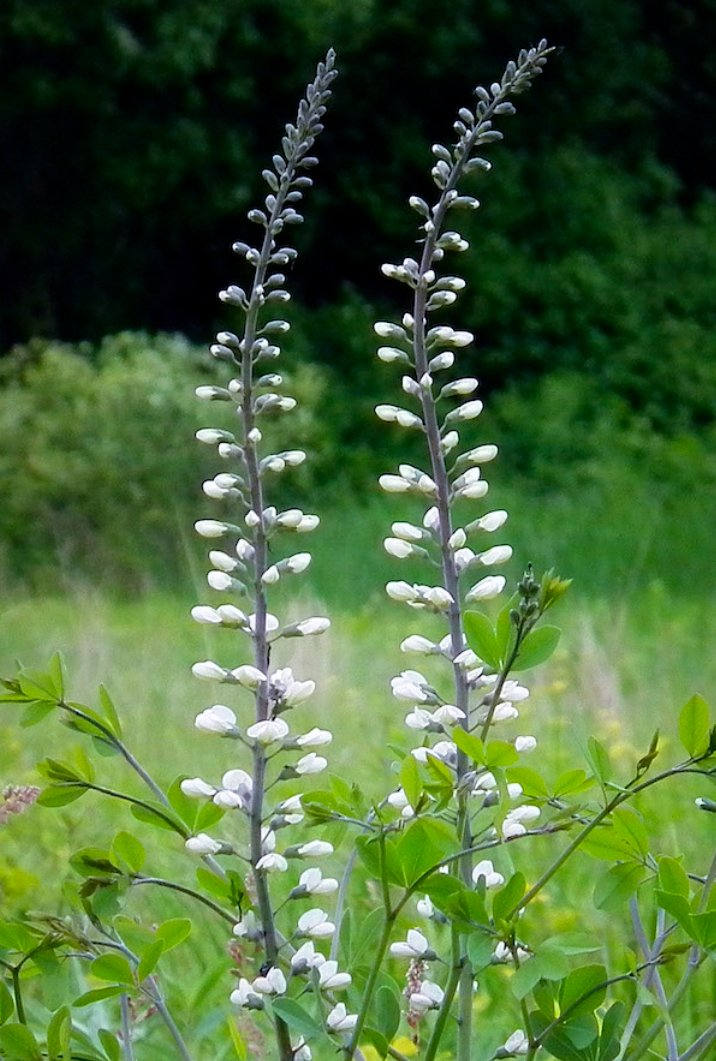 Image 1 of 7
Image 1 of 7

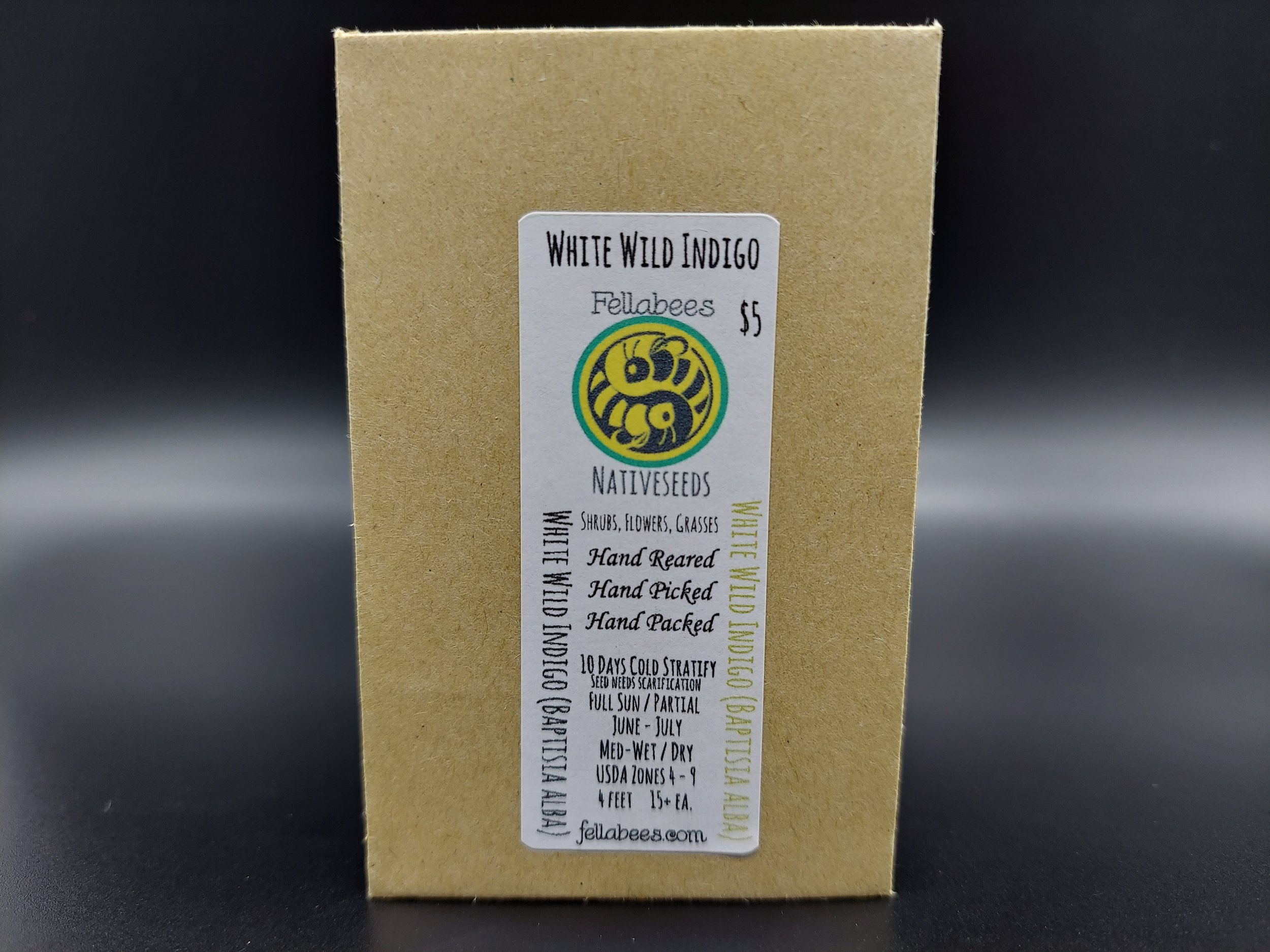 Image 2 of 7
Image 2 of 7

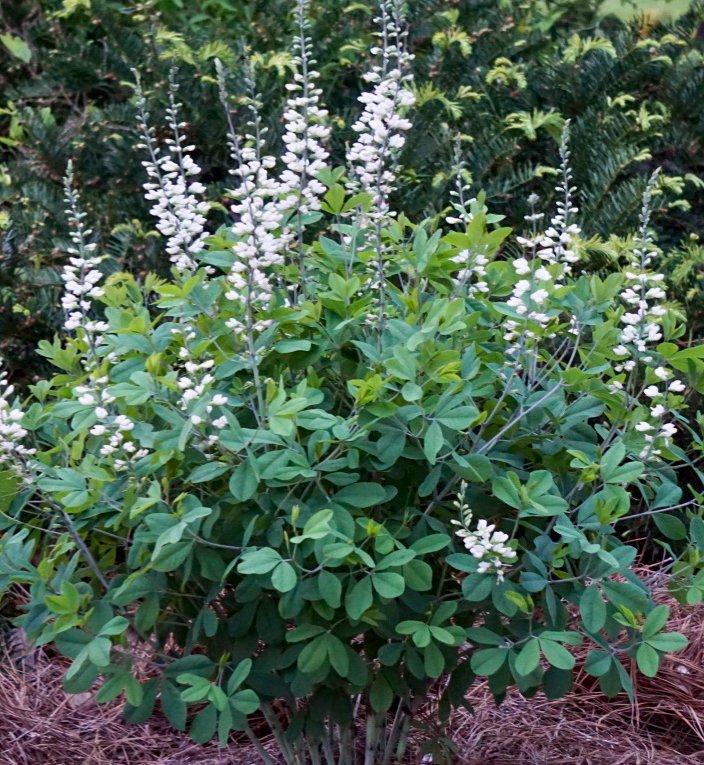 Image 3 of 7
Image 3 of 7

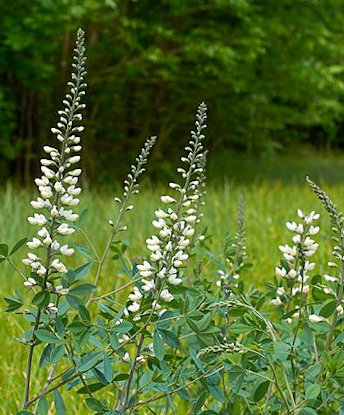 Image 4 of 7
Image 4 of 7

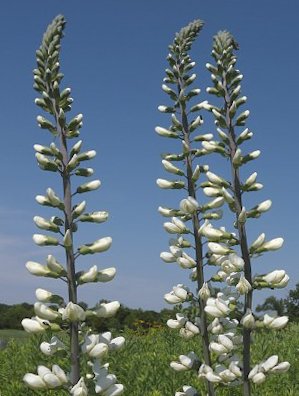 Image 5 of 7
Image 5 of 7

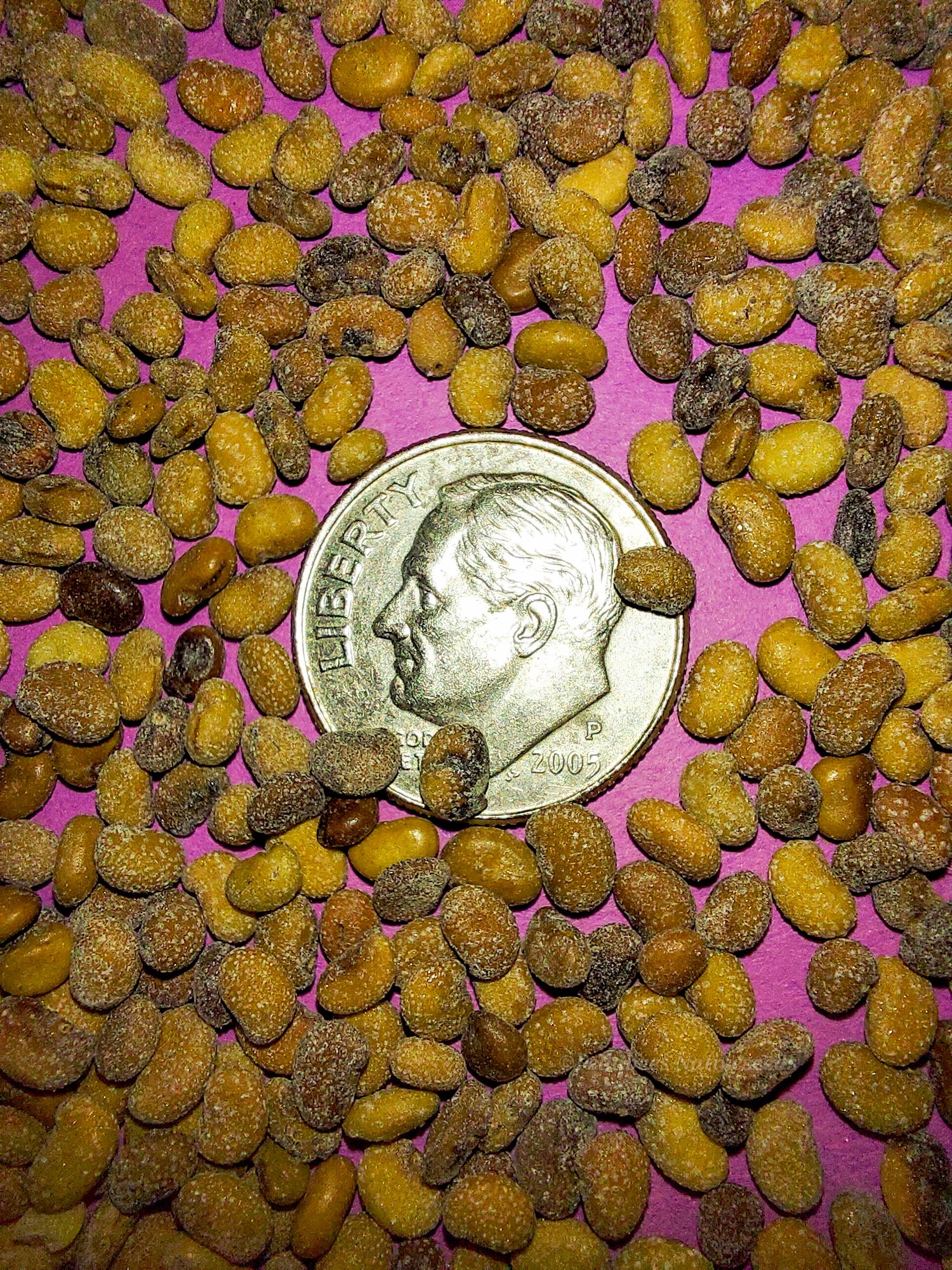 Image 6 of 7
Image 6 of 7

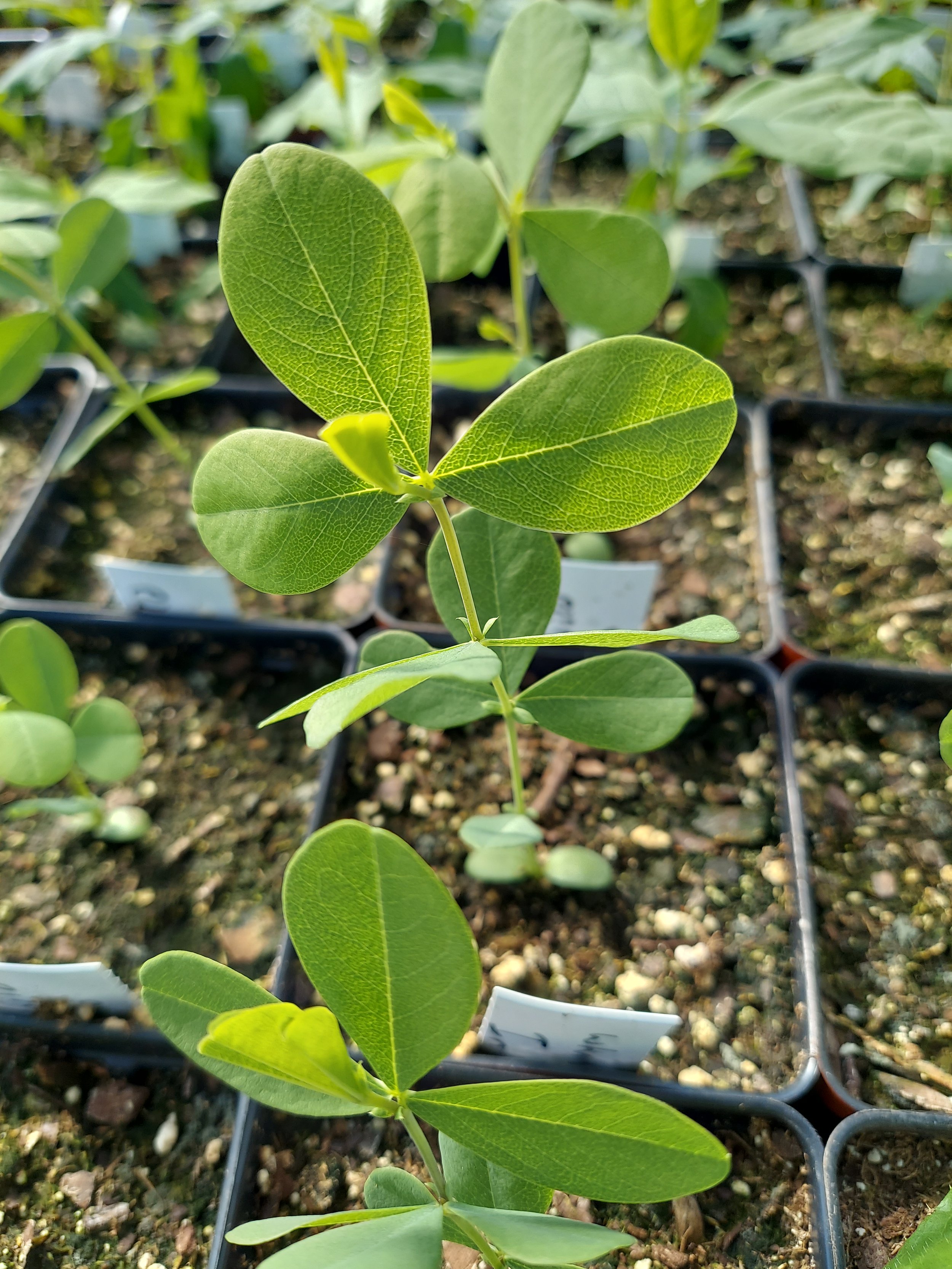 Image 7 of 7
Image 7 of 7








White Wild Indigo (Baptisia alba)
White Wild Indigo (Baptisia alba)
Baptisia alba, more commonly called White Wild Indigo or White False Indigo, is a herbaceous perennial plant in the bean family called Fabaceae. It is a early season species of native plant in central and eastern North America. White Wild Indigo is typically 2 to 3 feet tall, but if it favors its location it can be taller, with tall spikes of white, pealike flowers.
A vital prairie plant for many pollinators it is a host, or major benefit for caterpillars of the Duskywing Butterfly and the Indigo Stem Borer Moth, not to mention The Eastern Tailed-Blue, Clouded Sulfer, Southern Dogface and Orange Sulfer Butterflies!
This seed and plant get round, and get around! During winter the bases of the plant can shatter and break off of their base. As they do, they form tumbleweeds of themselves and spread seed via a ball blowing in the winter wind.
Leaves of Wild White Indigo have alternate arrangement, and are trifoliate, narrow, and oblong. White flowers bud out along its long spike inflorescence. Blooming can occur from April to July, earlier in the southern part of the range. The species is native to grasslands, but is grown in some gardens, as it favors moist soils.
Baptisia alba var. alba can be differentiated from its ecotype cousin B. alba var. macrophylla (syn. B. lactea and B. leucantha) on the basis that the former occurs only in the southeastern US and has fruits that hang downward when ripe.
Baptisia alba is typically described as a facultative upland plant (Facultative upland (FACU) - Usually occurs in non-wetlands (estimated probability 67% – 99%), but occasionally found in wetlands (estimated probability 1% – 33%).in all parts of its range.)
This plant is considered present but rare in several counties of the states of Minnesota, Nebraska, Michigan, Ohio and North Carolina.
Plant Details
USDA Zones: 4-9
Germination Needs: Seed needs scarification before, (Rub seeds between medium grit sandpaper to aerate the seed surface without crushing or opening the seed) 10 Days Cold Stratification,
Life Cycle: Perennial
Sun Exposure: Full to Partial
Soil Moisture: Medium-Wet, Medium, Medium-Dry, Dry
Plant Spacing: 2½-3½ feet
Height: 4 feet
Bloom time: June, July
Bloom Color: White
Advantages :
Pollinator Favorite: butterflies, moths, bees, wasps, beetles
Bird Favorite: seeds, insects, fruit, nectar, nesting, perchs.
Deer Resistant: Yes
Native to: Wisconsin, Minnesota, Iowa, Illinois, Indiana, Michigan, Ohio, Kentucky, Tennessee, Missouri, Arkansas, North Carolina, South Carolina, Georgia, Florida, Alabama, Mississippi, Louisiana, Texas, Oklahoma, Kansas, and Nebraska.
Introduced to: New York and Massachusetts
.
.
Packet quantities:
We pride ourselves on ethical, hands on, ecological management, using no mechanical or chemical methods whatsoever.
All of our native seed is hand reared, hand picked, and hand packed from native prairies under our exclusive management, never breaking chain of custody from the field until it is sent to you. Each packet is hand prepared for shipment by us, directly.
Small seed species will contain greater than 20-25 seed
Large seed species will contain greater than 10-15 seed
It is our mission to spread the wealth of native plant and pollinator ecological sustainability, and educate back yard gardeners as well as corporate and government entities in how to germinate, grow, and benefit from native synergies.
Thank you for your support, it is because of you, that we can grow together to do, what we do.🐛🦋🐝🐞🌾🌱🌼🧡
White Wild Indigo (Baptisia alba)
Baptisia alba, more commonly called White Wild Indigo or White False Indigo, is a herbaceous perennial plant in the bean family called Fabaceae. It is a early season species of native plant in central and eastern North America. White Wild Indigo is typically 2 to 3 feet tall, but if it favors its location it can be taller, with tall spikes of white, pealike flowers.
A vital prairie plant for many pollinators it is a host, or major benefit for caterpillars of the Duskywing Butterfly and the Indigo Stem Borer Moth, not to mention The Eastern Tailed-Blue, Clouded Sulfer, Southern Dogface and Orange Sulfer Butterflies!
This seed and plant get round, and get around! During winter the bases of the plant can shatter and break off of their base. As they do, they form tumbleweeds of themselves and spread seed via a ball blowing in the winter wind.
Leaves of Wild White Indigo have alternate arrangement, and are trifoliate, narrow, and oblong. White flowers bud out along its long spike inflorescence. Blooming can occur from April to July, earlier in the southern part of the range. The species is native to grasslands, but is grown in some gardens, as it favors moist soils.
Baptisia alba var. alba can be differentiated from its ecotype cousin B. alba var. macrophylla (syn. B. lactea and B. leucantha) on the basis that the former occurs only in the southeastern US and has fruits that hang downward when ripe.
Baptisia alba is typically described as a facultative upland plant (Facultative upland (FACU) - Usually occurs in non-wetlands (estimated probability 67% – 99%), but occasionally found in wetlands (estimated probability 1% – 33%).in all parts of its range.)
This plant is considered present but rare in several counties of the states of Minnesota, Nebraska, Michigan, Ohio and North Carolina.
Plant Details
USDA Zones: 4-9
Germination Needs: Seed needs scarification before, (Rub seeds between medium grit sandpaper to aerate the seed surface without crushing or opening the seed) 10 Days Cold Stratification,
Life Cycle: Perennial
Sun Exposure: Full to Partial
Soil Moisture: Medium-Wet, Medium, Medium-Dry, Dry
Plant Spacing: 2½-3½ feet
Height: 4 feet
Bloom time: June, July
Bloom Color: White
Advantages :
Pollinator Favorite: butterflies, moths, bees, wasps, beetles
Bird Favorite: seeds, insects, fruit, nectar, nesting, perchs.
Deer Resistant: Yes
Native to: Wisconsin, Minnesota, Iowa, Illinois, Indiana, Michigan, Ohio, Kentucky, Tennessee, Missouri, Arkansas, North Carolina, South Carolina, Georgia, Florida, Alabama, Mississippi, Louisiana, Texas, Oklahoma, Kansas, and Nebraska.
Introduced to: New York and Massachusetts
.
.
Packet quantities:
We pride ourselves on ethical, hands on, ecological management, using no mechanical or chemical methods whatsoever.
All of our native seed is hand reared, hand picked, and hand packed from native prairies under our exclusive management, never breaking chain of custody from the field until it is sent to you. Each packet is hand prepared for shipment by us, directly.
Small seed species will contain greater than 20-25 seed
Large seed species will contain greater than 10-15 seed
It is our mission to spread the wealth of native plant and pollinator ecological sustainability, and educate back yard gardeners as well as corporate and government entities in how to germinate, grow, and benefit from native synergies.
Thank you for your support, it is because of you, that we can grow together to do, what we do.🐛🦋🐝🐞🌾🌱🌼🧡
White Wild Indigo (Baptisia alba)
Baptisia alba, more commonly called White Wild Indigo or White False Indigo, is a herbaceous perennial plant in the bean family called Fabaceae. It is a early season species of native plant in central and eastern North America. White Wild Indigo is typically 2 to 3 feet tall, but if it favors its location it can be taller, with tall spikes of white, pealike flowers.
A vital prairie plant for many pollinators it is a host, or major benefit for caterpillars of the Duskywing Butterfly and the Indigo Stem Borer Moth, not to mention The Eastern Tailed-Blue, Clouded Sulfer, Southern Dogface and Orange Sulfer Butterflies!
This seed and plant get round, and get around! During winter the bases of the plant can shatter and break off of their base. As they do, they form tumbleweeds of themselves and spread seed via a ball blowing in the winter wind.
Leaves of Wild White Indigo have alternate arrangement, and are trifoliate, narrow, and oblong. White flowers bud out along its long spike inflorescence. Blooming can occur from April to July, earlier in the southern part of the range. The species is native to grasslands, but is grown in some gardens, as it favors moist soils.
Baptisia alba var. alba can be differentiated from its ecotype cousin B. alba var. macrophylla (syn. B. lactea and B. leucantha) on the basis that the former occurs only in the southeastern US and has fruits that hang downward when ripe.
Baptisia alba is typically described as a facultative upland plant (Facultative upland (FACU) - Usually occurs in non-wetlands (estimated probability 67% – 99%), but occasionally found in wetlands (estimated probability 1% – 33%).in all parts of its range.)
This plant is considered present but rare in several counties of the states of Minnesota, Nebraska, Michigan, Ohio and North Carolina.
Plant Details
USDA Zones: 4-9
Germination Needs: Seed needs scarification before, (Rub seeds between medium grit sandpaper to aerate the seed surface without crushing or opening the seed) 10 Days Cold Stratification,
Life Cycle: Perennial
Sun Exposure: Full to Partial
Soil Moisture: Medium-Wet, Medium, Medium-Dry, Dry
Plant Spacing: 2½-3½ feet
Height: 4 feet
Bloom time: June, July
Bloom Color: White
Advantages :
Pollinator Favorite: butterflies, moths, bees, wasps, beetles
Bird Favorite: seeds, insects, fruit, nectar, nesting, perchs.
Deer Resistant: Yes
Native to: Wisconsin, Minnesota, Iowa, Illinois, Indiana, Michigan, Ohio, Kentucky, Tennessee, Missouri, Arkansas, North Carolina, South Carolina, Georgia, Florida, Alabama, Mississippi, Louisiana, Texas, Oklahoma, Kansas, and Nebraska.
Introduced to: New York and Massachusetts
.
.
Packet quantities:
We pride ourselves on ethical, hands on, ecological management, using no mechanical or chemical methods whatsoever.
All of our native seed is hand reared, hand picked, and hand packed from native prairies under our exclusive management, never breaking chain of custody from the field until it is sent to you. Each packet is hand prepared for shipment by us, directly.
Small seed species will contain greater than 20-25 seed
Large seed species will contain greater than 10-15 seed
It is our mission to spread the wealth of native plant and pollinator ecological sustainability, and educate back yard gardeners as well as corporate and government entities in how to germinate, grow, and benefit from native synergies.
Thank you for your support, it is because of you, that we can grow together to do, what we do.🐛🦋🐝🐞🌾🌱🌼🧡
